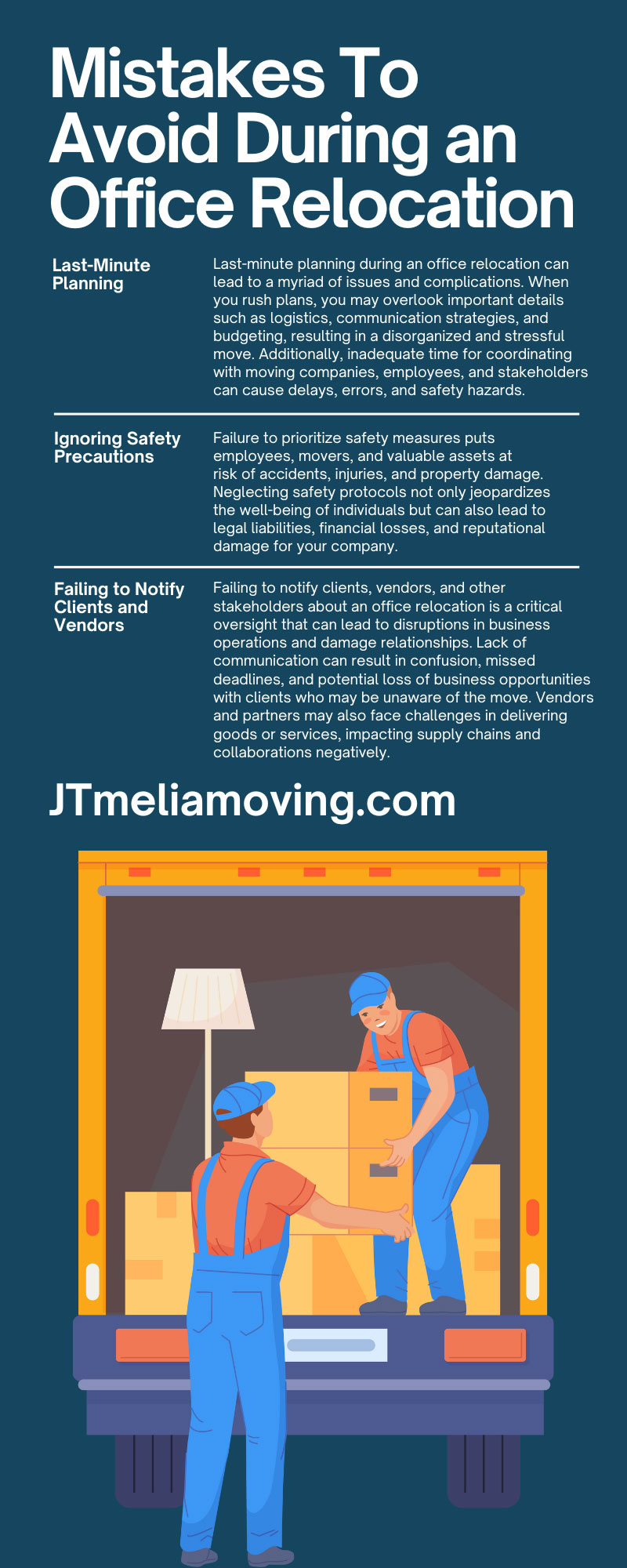Contents

Moving offices presents opportunities for growth, access to better facilities, and the potential for long-term cost savings. However, many organizations encounter pitfalls that can complicate the moving process. To help you navigate this transition smoothly, we’ve outlined six common mistakes to avoid during an office relocation. Use our tips to minimize downtime, maintain employee morale, and preserve business continuity.
Last-Minute Planning
Last-minute planning during an office relocation can lead to a myriad of issues and complications. When you rush plans, you may overlook important details such as logistics, communication strategies, and budgeting, resulting in a disorganized and stressful move. Additionally, inadequate time for coordinating with moving companies, employees, and stakeholders can cause delays, errors, and safety hazards.
Create a comprehensive timeline with clear milestones as soon as possible. Starting early gives you ample time to conduct thorough assessments, create detailed plans, and address any potential challenges that may arise. Speak with key stakeholders, including employees, during the planning stages for effective communication, collaboration, and buy-in, ensuring a smoother transition to the new office space.
Not Communicating Clearly
Inadequate communication with employees can cause uncertainty and resistance regarding the move. On the other hand, transparent communication fosters a sense of inclusion and cooperation among staff.
Follow these tips to communicate information about the move clearly to employees:
- Start early: Initiate communication about the office move 6 to 12 months in advance to allow employees time to digest the information.
- Be transparent: Clearly explain the reasons for the move and how it aligns with the company’s goals and objectives.
- Provide updates: Keep employees informed with regular updates on the progress of the relocation process.
- Encourage feedback: Create a feedback loop for employees to ask questions, share concerns, and provide input.
- Address concerns: Acknowledge and address any concerns or uncertainties employees may have about the move.
- Offer support: Provide resources and support to help employees navigate the transition smoothly.
- Celebrate milestones: Recognize and celebrate key milestones in the relocation process to maintain employee morale and engagement.
Addressing questions and concerns promptly can reduce anxiety and boost morale. Effective communication also ensures that everyone is aligned and working toward the same goal.
Ignoring Safety Precautions
Failure to prioritize safety measures puts employees, movers, and valuable assets at risk of accidents, injuries, and property damage. Neglecting safety protocols not only jeopardizes the well-being of individuals but can also lead to legal liabilities, financial losses, and reputational damage for your company.
Conduct a comprehensive risk assessment before the relocation process begins. This assessment should identify potential hazards, establish safety guidelines, and implement precautionary measures to minimize the chances of accidents. Prioritize employee safety by providing proper training on safe moving practices, providing necessary protective gear, and clearly communicating emergency procedures.
Pro Tip: Experienced Movers Enhance Safety
Professional commercial movers bring expertise and experience that can significantly reduce the risk of accidents during an office relocation. Their specialized tools and training simplify the handling of heavy and delicate items. For an efficient and safe transition, contact movers with experience in commercial relocations to see how they can help.
Failing to Notify Clients and Vendors
Failing to notify clients, vendors, and other stakeholders about an office relocation is a critical oversight that can lead to disruptions in business operations and damage relationships. Lack of communication can result in confusion, missed deadlines, and potential loss of business opportunities with clients who may be unaware of the move. Vendors and partners may also face challenges in delivering goods or services, impacting supply chains and collaborations negatively.
To avoid these problems, develop a comprehensive communication plan well in advance of the move. Start by identifying all relevant parties and crafting tailored messages outlining the details of the relocation, including the new address, contact information, and any changes in services or operations. Utilize a variety of communication channels, such as email, phone calls, meetings, and social media, to ensure that stakeholders receive the information promptly and clearly. Providing regular updates and addressing any questions or concerns that arise demonstrates professionalism, transparency, and a commitment to maintaining strong relationships.
Choosing the Wrong Moving Company
Selecting the wrong moving company for an office relocation can lead to a host of complications. Issues such as delays, damaged equipment, loss of critical documents, and lack of professionalism can arise when working with an unreliable or inexperienced moving company. This adds unnecessary stress and can lead to potential financial losses.
To avoid the mistake of choosing the wrong moving company, thoroughly research professional movers with office relocation experience. Request and review references, check each company’s reputation and track record, verify licenses and insurance coverage, and obtain detailed quotes and contracts outlining services and costs.
Pro Tip: Choose a Local Mover
Working with a local moving company offers the advantage of their familiarity with the area, potentially leading to smoother logistics and quicker response times during the office relocation. Local moving companies in Houston understand the city’s layout and traffic patterns, making navigation more efficient. Additionally, professional local movers prioritize building strong relationships with their customers, and you can enjoy high-quality customer service.
Underestimating Downtime
Failing to account for downtime can impact productivity and revenue. Many businesses underestimate the time it takes to pack, transport, and unpack office equipment. This oversight can result in extended periods of inactivity, delayed project timelines, and disruptions in service delivery, creating chaos and frustration among employees and clients.
To mitigate this risk, create a detailed timeline that includes all phases of the move—packing, moving, unpacking, and setting up the new office space. Communicate this timeline to your team and the moving company to ensure everyone is on the same page. Consider scheduling the move during off-peak hours or weekends to minimize disruption to daily operations.
An office relocation is a significant undertaking that involves careful planning and attention to detail. To ensure a smooth move, start planning early and create a detailed timeline with clear milestones. Communicate transparently with employees, clients, and vendors about the move, addressing their concerns and keeping them informed with regular updates. Finally, prioritize safety by conducting risk assessments and choose a reputable moving company with commercial relocation experience for an efficient transition.

 Local and Long Distance
Local and Long Distance Office Relocations
Office Relocations International Movers
International Movers Houston Long Term Storage
Houston Long Term Storage